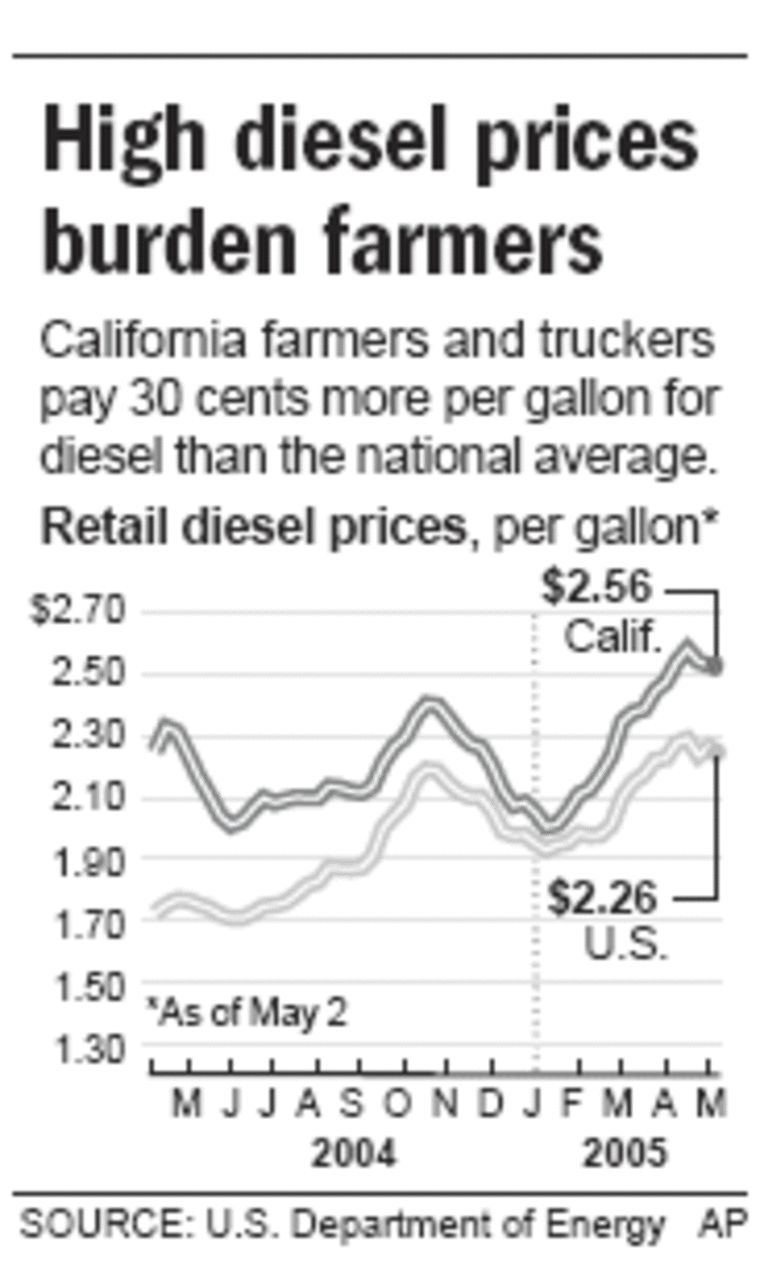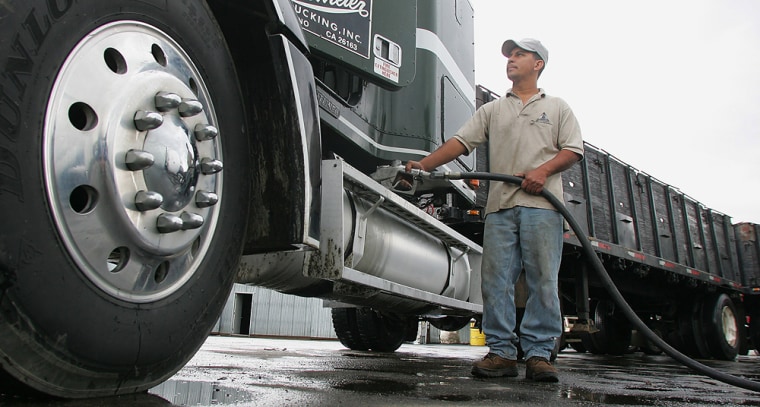The farmers who grow many of the fresh fruits and vegetables for the nation's dinner tables say the rising cost of oil is making this one of their toughest planting seasons yet — and might shove some of them out of business.
Drivers nationwide have had to pay more as political volatility and increased demand worldwide push up gas prices, said Ron Planting, an economist with the American Petroleum Institute. A barrel of crude oil now sells for as much as $55, up from $35 this time last year.
But farmers are the ones caught in a "three-way whammy," said Keith Nilmeier, who just finished harvesting his 185 acres of oranges outside Fresno. Farmers are squeezed by higher prices for the diesel that runs their harvesting and irrigation equipment, for the fertilizer made by combining nitrogen with the hydrogen in natural gas, and for the transportation of crops to your local supermarket.
"We're the bottom link on this whole chain, and we have no one to pass our costs on to," said Nilmeier. "We just have to take it and try to keep going."

Farmers nationwide have seen the price of fuel more than double, from 96 cents a gallon in April 2002 to $1.97 in April 2005. In California alone, they use use more than 1.5 million gallons of diesel a day at the peak of harvest. Truckers in the state, which has the highest fuel prices in the country, pay about $2.56 a gallon at the pump — 28 cents more than this time last year — for diesel, which sells for about $2.26 a gallon nationally.
Nationally, U.S. farmers will spend about 10 percent more this year — about $3 billion — on costs including fuel and fertilizer, even as the price consumers pay for fruits and vegetables remains relatively stable, said Terry Francl, senior economist with the American Farm Bureau Federation, a Washington, DC-based group representing farm interests.
"Farmers are price takers, not price makers," he said. "This means they've just had their income reduced by $3 billion."
The pain of higher fuel prices is being felt throughout the food industry.
Many of the truckers who distribute produce are charging higher prices or getting out of the business, making it harder for farmers to get their crops to wholesalers. Distributors providing fuel directly to small farmers are finding it hard to buy fuel and sell it at a profit in such a volatile market.
Fertilizer manufacturers are also facing much higher domestic natural gas prices, driving the prices they charge higher. The fertilizer's basic component, anhydrous ammonia, is made by combining natural gas and air at high temperature and pressure. The chemical now sells for about $416 a ton — up from $250 a ton three years ago.
"Fertilizer prices went crazy," said Craig Ito, grows peaches, plums, nectarines and other fruit and in Fresno, the county with the country's highest farming grosses.
California has led the nation in agricultural production since World War II. The state's vast Central Valley — a swath of farmland more than twice the size of Massachusetts — grows most of the world's almonds, and most U.S.-grown nectarines, walnuts and raisins.
Ito also runs a packing and shipping business that distributes Central Valley fruit. He still ships to places as far away as Taiwan and Japan, but he lost some buyers on the East Coast recently when the price of freight made California fruit too expensive to compete. To keep up with East Coast peaches, he said, he'd have to sell peaches that had sold for $10 to $12 a box for just $8.
"That's red ink for us," Ito said.
Produce truckers are also charging more. Nilmeier, who also owns a small fleet of diesel trucks and does harvesting and hauling for other farmers, is charging a 24 percent fuel service surcharge, "and that's just to keep me at parity," he said.
But diesel prices are climbing so high that many farmers are hard-pressed to find truckers willing to carry their produce, even at a higher price.
"We've always had truck shortages in June. Now it's a season-long thing," said peach farmer Cliff Sadoian.
Most of the diesel in California — 80 percent of the six billion gallons consumed each year in the state — is sold through independent fuel distributors. But even these "jobbers," who deliver small batches of bulk diesel directly to farms, say they have to pass their extra expenses along to farmers.
"I hate to do it, but I don't have any room to absorb that," said Tim Ward, who has four tanker trucks delivering diesel to Central Valley growers.
Ward has dealt with fluctuating fuel prices throughout his 35 years in the business, but the recent hikes in diesel pushed his expenses so far over his budget that he had to borrow repeatedly — until his bank stopped lending.
"That nearly put us out of business," Ward said. "We can only stand so much. Whether or not we can survive it this year, we'll have to see."
Meanwhile, farmers like Nilmeier are doing what they can to reduce their costs.
They're figuring out ways to cut down on tractor use, trying to use less fertilizer, and increasing security against the diesel thieves who have stolen 12,971 gallons of fuel from California farms already this year, according to state law enforcement.
"We're the first link on that chain," Nilmeier tries to remind people. "Without us, none of those other links are any good. There's nothing to pick, to haul, to process, to sell. There's nothing to eat. If we don't make it, no one does."
